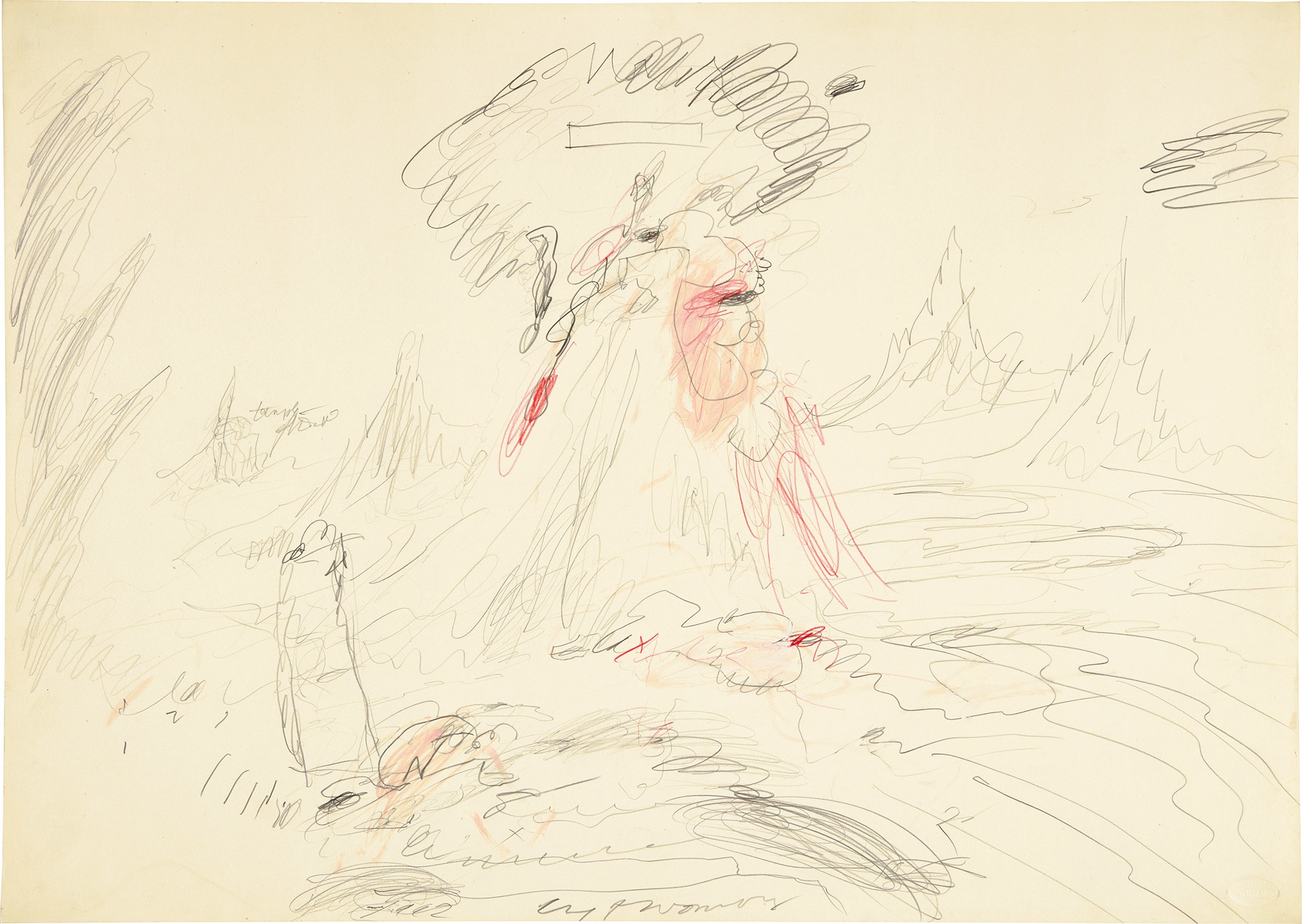

Property from an Important Private Collection
116Ο◆
Cy Twombly
Untitled
Full-Cataloguing
Delivering the full force of Cy Twombly’s unique pictorial language, Untitled, 1962, is emblematic of the groundbreaking body of work that Twombly created during his acclaimed Baroque period. Pulsating with visceral energy, the work presents the viewer with a dramatic landscape hovering between abstraction and figuration. Intimately related to the painting Vengeance of Achilles, 1962, Kunsthaus Zurich, the composition centers on a triangular form built up with vibrant red lines, the word “temple” illegibly scribbled to the left of it. Evocative of an erupting volcano, it is as if Twombly here draws us into a mythological landscape of his imagination.
Created five years after Twombly’s career and life-defining move to the ancient city of Rome in 1957, Untitled delivers the full force of Twombly’s unique pictorial language that at once invokes the classical past and his immediate contemporary experience. While his contemporaries were finding inspiration in pop culture or Minimalism, Twombly, starting in 1960, embarked upon a series of groundbreaking works inspired by the epic and dramatic panoramas and classical landscapes of the High Renaissance and Baroque. Heiner Bastian’s observation of the paintings Twombly created at the time perfectly captures the epic scene that Untitled presents: “Twombly’s…works reveal an Olympian landscape, Mount Parnassus rising above the temple of the sacred oracle at Delphi... They invoke the song of the muses of which, it is said, that stopped time itself and that the dome of heaven, and the stars and the sea hesitated, grew calm, drew to a halt on hearing their music...These works are real rather than intangible notions of a distant magical landscape surging up suddenly before us; and, in their actuality, they resist all other empirical space” (Heiner Bastian, Cy Twombly, Catalogue Raisonné of the Paintings, Volume II 1961 – 1965, Munich, 1993, p. 25).
Untitled vividly illustrates how, within Twombly’s Baroque period of 1960–1963, the cycle of works created from 1962 to 1963 specifically assumed a much more visceral and existential tone as Twombly began to take a panoply of Dionysian episodes of epic violence and fateful assassinations from Italian and Roman history as a point of departure. While Twombly’s practice cannot be confined to one set of references or circumstances, this radical shift has been viewed in relation to the darkening political mood at the time – characterized by the escalation of Cold War tensions and the threat of imminent nuclear apocalypse as epitomized in the Cuban Missile Crisis of 1962, the deteriorating situation in Vietnam, and by, November 1963, the assassination of President John F. Kennedy. It is telling that many compositions from this period, the present work included, evoke associations with the rocket-borne high-altitude experimental nuclear explosions that had provoked widespread protests from scientists and astronomers.
While this discrete period in Twombly’s oeuvre has given rise to what are now widely regarded as some of his greatest masterpieces – including Leda and the Swan, 1962, and Nine Discourses on Commodus, 1963 – at the time Twombly’s work was largely met with dismissive reviews by an art world in thrall of Pop art and hard-edged Minimalism, and wary of the painterly tradition of “old Europe.” Ironically, while the European embrace of post-war American art had been sanctioned – Robert Rauschenberg won the grand prize at the Venice Biennial the same year – Twombly was being castigated as a “passé foreigner and set outside the forming canon that positioned [Jasper] Johns and Rauschenberg…as the crucial precursors of the aesthetics of the 1960s” (Kurt Varnedoe, Cy Twombly A Retrospective, New York, 1994, p. 39). It was largely thanks to the Galleria La Tartaruga in Rome, from which Untitled originates, that Twombly received the support so essential for the development of his career – which spanned over 60 years – and which is now universally celebrated as one of the central positions in the history of postwar painting. Situated at this pivotal crossroads, Untitled is a testimony to Twombly’s unwavering vision and unbridled innovation.
Cy Twombly
American | B. 1928 D. 2011Cy Twombly emerged in the mid-1950s alongside New York artists Jasper Johns and Robert Rauschenberg. While at first developing a graffiti-like style influenced by Abstract Expressionist automatism–having notably studied under Franz Kline and Robert Motherwell at the legendary Black Mountain College between 1951 and 1952–Twombly was a prominent figure in the new generation of artists that challenged the abstract orthodoxy of the New York School. Twombly developed a highly unique pictorial language that found its purest expression upon his life-defining move to Rome in 1957. Simultaneously invoking classical history, poetry, mythology and his own contemporary lived experience, Twombly's visual idiom is distinguished by a remarkable vocabulary of signs and marks and the fusion of word and text.
Cy Twombly produced graffiti-like paintings that were inspired by the work of Willem de Kooning, Jackson Pollock and Robert Motherwell. His gestural forms of lines, drips and splattering were at first not well-received, but the artist later became known as the leader of the estrangement from the Abstract Expressionism movement. Full of energy and rawness, Twombly's pieces are reminiscent of childhood sketches and reveal his inspiration from mythology and poetry.